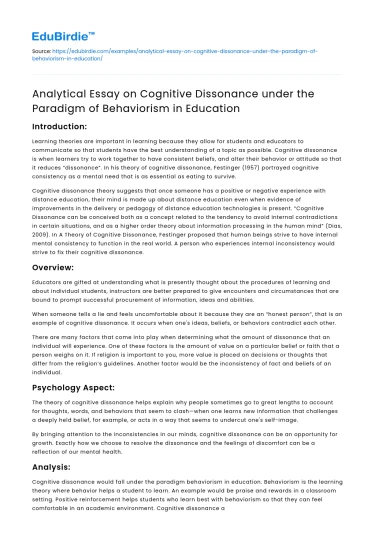Introduction:
Learning theories are important in learning because they allow for students and educators to communicate so that students have the best understanding of a topic as possible. Cognitive dissonance is when learners try to work together to have consistent beliefs, and alter their behavior or attitude so that it reduces “dissonance”. In his theory of cognitive dissonance, Festinger (1957) portrayed cognitive consistency as a mental need that is as essential as eating to survive.
Cognitive dissonance theory suggests that once someone has a positive or negative experience with distance education, their mind is made up about distance education even when evidence of improvements in the delivery or pedagogy of distance education technologies is present. “Cognitive Dissonance can be conceived both as a concept related to the tendency to avoid internal contradictions in certain situations, and as a higher order theory about information processing in the human mind” (Dias, 2009). In A Theory of Cognitive Dissonance, Festinger proposed that human beings strive to have internal mental consistency to function in the real world. A person who experiences internal inconsistency would strive to fix their cognitive dissonance.
Save your time!
We can take care of your essay
- Proper editing and formatting
- Free revision, title page, and bibliography
- Flexible prices and money-back guarantee
Overview:
Educators are gifted at understanding what is presently thought about the procedures of learning and about individual students, instructors are better prepared to give encounters and circumstances that are bound to prompt successful procurement of information, ideas and abilities.
When someone tells a lie and feels uncomfortable about it because they are an “honest person”, that is an example of cognitive dissonance. It occurs when one's ideas, beliefs, or behaviors contradict each other.
There are many factors that come into play when determining what the amount of dissonance that an individual will experience. One of these factors is the amount of value on a particular belief or faith that a person weighs on it. If religion is important to you, more value is placed on decisions or thoughts that differ from the religion’s guidelines. Another factor would be the inconsistency of fact and beliefs of an individual.
Psychology Aspect:
The theory of cognitive dissonance helps explain why people sometimes go to great lengths to account for thoughts, words, and behaviors that seem to clash—when one learns new information that challenges a deeply held belief, for example, or acts in a way that seems to undercut one's self-image.
By bringing attention to the inconsistencies in our minds, cognitive dissonance can be an opportunity for growth. Exactly how we choose to resolve the dissonance and the feelings of discomfort can be a reflection of our mental health.
Analysis:
Cognitive dissonance would fall under the paradigm behaviorism in education. Behaviorism is the learning theory where behavior helps a student to learn. An example would be praise and rewards in a classroom setting. Positive reinforcement helps students who learn best with behaviorism so that they can feel comfortable in an academic environment. Cognitive dissonance allows students to provide a reason for their actions to prevent acting out. The incorporation of cognitive dissonance into models of basic learning-processes to foster the students’ self-awareness of psychological conflicts among their personal beliefs, ideals, and values and the reality of contradictory facts and information, requires the students to defend their personal beliefs. Afterwards, the students are trained to objectively perceive new facts and information to resolve the psychological stress of the conflict between reality and the student's value system. Moreover, educational software that applies the derived principles facilitates the students’ ability to successfully handle the questions posed in a complex subject.
Learning Paradigm:
Learning Theory describes how students absorb, process, and retain knowledge during learning. Cognitive, emotional, and environmental influences, as well as prior experience, all play a part in how understanding, or a world view, is acquired or changed and knowledge and skills retained.
Cognitivism replaced behaviorism in the 1960s as the common learning theory. Cognitivism centers around the inward mental exercises. Human personality is significant and vital for seeing how individuals learn. Mental procedures, for example, thinking, memory, knowing, and critical thinking should be investigated. Information can be viewed as composition or emblematic mental developments. Learning is characterized as change in a student's schemata.
Behaviorists look at learning as an aspect of conditioning and advocate a system of rewards and targets in education. Educators who embrace cognitive theory believe that the definition of learning as a change in behavior is too narrow, and study the learner rather than their environment—and in particular the complexities of human memory. Those who advocate constructivism believe that a learner's ability to learn relies largely on what they already know and understand, and the acquisition of knowledge should be an individually tailored process of construction. Behaviorism was primarily founded by John Watson in 1913. “Behaviorism refers to a psychological approach which emphasizes scientific and objective methods of investigation. The approach is only concerned with observable stimulus-response behaviors, and states all behaviors are learned through interaction with the environment. (Simply Psychology).
Behaviorism is a systematic approach to understanding the behavior of humans and other animals. It assumes that behavior is either a reflex evoked by the pairing of certain antecedent stimuli in the environment, or a consequence of that individual's history, including especially reinforcement and punishment contingencies, together with the individual's current motivational state and controlling stimuli. Although behaviorists generally accept the important role of heredity in determining behavior, they focus primarily on environmental events.






 Stuck on your essay?
Stuck on your essay?

